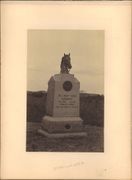Welcome!
Click on image for a better view:

Superb 10th NY Cavalry Gettysburg Monument Albumen. This image (& mount) were removed from an album at some point. Pencil notation near bottom reads: "Tipton 1882".
Image and mount measure roughly 7.5" x 10.5", and are in superb condition. No photographers backmark.
$125.00 plus shipping
NEW YORK
TENTH CAVALRY
(Three Years)
Tenth Cavalry.-Cols., John C. Lemmon, William Irvine, Mathew H.
Avery; Lieut.-Cols., William Irvine, M. H. Avery, Frederick L.
Tremain, Benjamin F. Sceva; Majs., M. H. Avery, George W.
Kennedy, James M. Reynolds, John H. Kemper, Theodore H. Weed,
Martin H. Blynn, Alva D. Waters, William A. Snyder.
This regiment, known also as the Porter Guard, is enumerated by
Col. Fox as one of the three hundred fighting regiments of the
war. It was organized at Elmira during the fall of 1861, from
companies recruited in the counties of Chemung, Chenango,
Cortland, Erie, Fulton, Onondaga and Steuben.
Cos. A, B, C, D, E, F, G and H were mustered into the U. S.
service from Sept. 27 to Dec. 28, 1861, for three years; I, K and
L were mustered in at Elmira on Oct. 29-30, 1862, and M in Nov.
and Dec., 1862. Cos. I, K and L joined the regiment on Dec. 5,
1862, and M in Feb., 1863, completing the regimental
organization.
At the expiration of their term of service in the fall of 1864,
the original members of the first eight companies, except
veterans and recruits, were mustered out, and the regiment was
retained in service until July 10, 1865, when it was consolidated
with the 24th N. Y. cavalry, the consolidated force being
designated as the 1st provisional regiment N. Y. cavalry.
The first eight companies left the state on Dec. 24, 1861, and
were stationed at Gettysburg during the remainder of the winter.
In the spring and summer of 1862, it did railroad guard duty and
served in the defenses of Washington, where it was mounted. It
saw its first active service in the Manassas campaign of 1862,
and was in Bayard's brigade at Fredericksburg.
It participated in the Stoneman raid at the time of the
Chancellorsville campaign, with the 1st brigade, 3d cavalry
division. On June 14, 1863, it was assigned to the 3d brigade,
2nd division (Gen. D. McM. Gregg's), in which it served until the
close of the war, Gen. Crook commanding the division in the final
campaign of 1865.
Its brigade commanders were Gens. J. I. Gregg and H. E. Davies,
Jr. The regiment encountered its hardest fighting at Brandy
Station in June, 1863, where it lost 6 killed, 18 wounded and 61
missing. At Middleburg its loss was 30; at Sulphur Springs,
Auburn, Bristoe and Catlett's station in October, 53; at Haw's
shop and Hanoverton, 42; at Trevilian Station, 21; at St. Mary's
Church, 22; and at Boydton road, 17.
In the final Appomattox campaign its losses aggregated 72 killed,
wounded and missing. Lieut.-Col. Tremain, a brilliant young
officer, died of wounds received at Hatcher's run. The following
extract from the muster-out rolls of the regiment shows the sort
of stuff of which the regiment was made: "Lieut. William J. Rabb
(Co. D); killed at Brandy Station, by a saber-thrust through the
body while lying under his horse; he would not surrender."
Corp. Andrew Bringle, Corp. James L. Cary, Capt. N. D. Preston,
and Sergt. Llewellyn P. Norton, were awarded medals of honor for
gallantry in action by the secretary of war. The regiment lost
while in service 9 officers and 97 men killed or died of wounds;
1 officer and 151 men died of disease, accident, in prison, etc.,
a total of 258, out of an enrollment of 2,029 officers and men.
Among its important engagements were Leesburg, Beverly ford,
Middleburg, Gettysburg, Shepherdstown, Sulphur Springs, Auburn,
Bristoe Station, Morrisville, Todd's tavern, near Richmond, Haw's
shop, Trevilian Station, King and Queen Court House, St. Mary's
Church, Deep Bottom, Lee's mill, Reams' station, Poplar Spring
Church, Boydton road, Prince George Court House, Disputanta
Station. Stony Creek Station, Hatcher's run, Dinwiddie Court
House, Sailor's creek and Farmville.
Source: The Union Army, Vol. 2, p. 190
